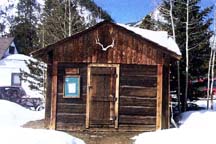
Like many western mountain towns, Frisco, Colorado (population 2,531) began as a small mining community, with gold and silver mines covering nearby mountainsides.
Frisco was founded in 1879, and by 1884 the permanent population reached 250, with two railroads and many businesses, hotels, and saloons. Mining boomed until the early 1900s, and by 1930 the town’s population had dropped to 18. During World War II, Frisco’s economy shifted from mining to skiing, and today the economy centers around tourism.
Many of the community’s historic older buildings are still in existence, and Frisco’s historic Main Street blends the new with the old. The Frisco Historic Park includes the Schoolhouse Museum, in its original location, and 11 other relocated historic structures from different areas of the community, ranging from the town’s first jail to the first church.
Each building represents a different period in Frisco’s history. The structures have been converted into new uses: some house exhibits on Frisco’s early days, others are rented to local artisans to sell their wares, and the Log Chapel is rented for wedding ceremonies.
The Frisco Historical Society sponsors such special events as Founder’s Day, Snowshoe Through History hikes, Bike to the Mines tours, and arts and crafts shows. An annual cemetery tour highlights the lives of famous historical Frisco residents. The Historic Colorado Treasure Map highlights historical and cultural heritage sites in Frisco’s Summit County and three neighboring counties. Visitors follow the map and collect stamps from each historic site.
Designated a Preserve America Community in March 2006.